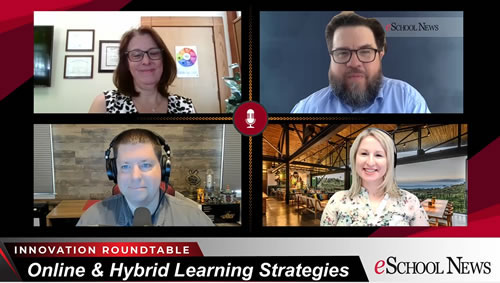We can’t discuss online and hybrid learning without acknowledging the role the COVID-19 pandemic played in forcing districts to move fully online for virtual instruction, later paving the way for hybrid learning as classrooms slowly reopened for small groups of students. But simply teaching and learning through a device isn’t enough, and moving instruction online requires approaches and resources to ensure students have tools that enable deeper learning and active student engagement.
During an eSchool News Innovation Roundtable with a focus on online and hybrid learning, moderated by eSchool News Content Director Kevin Hogan, district edtech innovators discussed their experiences with online and hybrid learning before and after the pandemic, how they’ve made such approaches work for teachers and students, and what they think this learning modality will look like in the future.
Participants included:
- Susan Moore, Director of Technology, Meriden Public Schools in Connecticut
- Misty Shea, Educational Technology Facilitator, Keller Independent School District in Texas
- Jeffrey Bradbury, Technology Education / Digital Media Teacher New Milford Public Schools in Connecticut
One of the biggest takeaways: The pandemic forced an online and hybrid learning revolution.
“Pre-pandemic, Meriden was already dipping its toe into online learning, so we had some tech-savvy teachers doing things with Moodle or Schoology,” Moore. Some teachers had started in Google Classroom, but it was still in its infancy and didn’t have a lot of features at the time. It was mainly used by early adopters who were looking for a way to flip their classroom. The other way we were using it was for personalized learning experiences. If a student had an interest in learning about something, and we didn’t have a teacher qualified to teach that or who had experience teaching it, we were allowing students to self-design programs of study around an area of interest through a MOOC or Coursera. We had some experience with online learning.”
Then came the pandemic.
“We really did a lot in getting everybody online. The easiest access point for us was using Google Classroom. We did our best to support teachers with our technology integration specialists,” Moore added. “Today, I think you’d be hard-pressed to find a teacher in the district who is NOT using Google Classroom, and we have those teachers using more advanced models, such as a very robust Moodle course, but it’s rare that a teacher doesn’t have some sort of online content available for students. It became such a game-changer in making resources available to students when they’re not in the classroom.”
“Getting some kind of learning management system up and running is successful. I talk a lot about that innovation curve–making sure there’s always a few people in the district who will get it, move with it, and have at it,” said Bradbury. “How do you take that innovation and start to move it throughout the district? How do you get those first followers and get over the humps so every single teacher over there is not only seeing it, but learning from it, experiencing it, and being able to bring that down to their students? I’ve been able to help people create that vision for educational technology. When you walk into that classroom, what do you want to see, what do you want learning to look like, how do you want classrooms to be innovative?”
Creating a vision based on a strategic plan is among the first steps to bring innovation to life.
“Start with [districts’ strategic plan] … take the district’s vision and through instructional coaching, through educational technology, help to form a vision that will show what students can do in the classroom to help them be successful,” he noted.
“Pre-pandemic, we had little pockets of teachers who were doing these amazing things. We’ve always told our teachers it will be a lot easier for them if they have some kind of online aspect. We were always trying to help teachers with a process to make things easier, so technology was that equalizer,” said Shea. “Then the pandemic happened, and wow. We went full throttle; our curriculum coordinators were all hands on deck. We talked about pedagogy, how to really engage students online, making sure [teachers were] building not just that surface-level [resources], but digging deeper online. We were course designing and co-teaching,” she said. As the pandemic abated, teachers were left with more freedom to incorporate online and hybrid resources.
“All those cool things we taught them pre-pandemic, they’re getting to utilize in a one-to-one device. You get to gamify learning a little easier because the students have devices. Are there issues with that? One hundred percent. We’re always keeping our face forward–how can we use the pedagogy, use what we have online, and convince those teachers that the amazing things they’ve done in their classrooms are not changing? You’re still going to do that amazing instruction, you’re still going to collaborate in the classroom, have great discussions, but now we have this really cool tool that can take it beyond and make it more global and impactful,” she said. “I’m excited that schools were forced into this because it really did open doors that we were cracking open, but we weren’t ready to throw the doors open. The pandemic forced us into that. I see more amazing things than I see pain points.”
See more eSN Innovation Roundtables exploring critical education issues
Related:
Why blended learning is a top 12 way to help those most in need
Where does blended learning fit in post-pandemic classrooms?
For more news on online and hybrid learning, visit eSN’s Digital Learning hub


